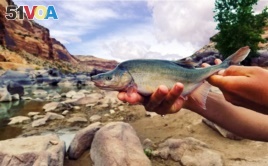09 May, 2018
Fish need insects for food. So, healthy rivers have healthy insect populations. However, in the United States, part of the Colorado River has an insect shortage that has left many fish without food.
Researchers are hoping a month-long water-flow experiment will improve the situation. The U.S. Geological Survey project involves the release of low, continuous water flow from Glen Canyon Dam. This will give insect eggs, which they lay just below the water's surface, a better chance to survive.
The Colorado runs 2,330 kilometers from the Rocky Mountains of Colorado to Lake Mead, on the border between the states of Arizona and Nevada. The Glen Canyon Dam is near the border between the states of Utah and Arizona.
Lacking diversity
"For whatever reason, downstream of Glen Canyon Dam really lacks diversity," said Scott VanderKooi, who runs the U.S. Geological Survey's Grand Canyon Monitoring and Research Center in Flagstaff.
Scientists expect a 26 percent increase in insects, such as black flies and midges, by next summer. Scientists say that when insect populations grow, so do the populations of other animals such as fish, bats, birds and other insect eaters.
Insects attach their eggs to hard surfaces, such as rocks or wood, on riversides. As water from dams rises and falls the eggs can lose their cover and dry out.
If they remain above the water line for even an hour, they die, said Jeff Muehlbauer, a research scientist with the Geological Survey.
The water flows are part of a larger plan approved in late 2016 for operations at Glen Canyon Dam to improve fish life. The dam holds back Lake Powell.
John Hamill, a volunteer with the organization Trout Unlimited, says the experiments will help explain the current situation of all the different river resources. Then, officials can make changes based on how the river ecosystem is changing.
Studying flies
People often fish along a 25 kilometer run of the Colorado River below the dam. However, a lack of insects means some of the fish caught are smaller than normal. Hamill says this has caused a lot of people to fish in different places.
"It hasn't been a very dependable fishery," Hamill said.
Ted Kennedy started working at the Geological Survey in 2002. He said at that time scientists had noted the low number of flies and other insects throughout the Grand Canyon.

This undated photo provided by the U.S. Fish and Wildlife Service shows a humpback chub in the Colorado River in Colorado near the Utah border.
Kennedy began studying the lives of insects before they hatch. He asked river guides and students for help studying the adult insect life as well.
Since 2012, the volunteers have set out plastic containers for an hour each night. A special light is attached that leads the insects into the containers.
The evidence from the containers showed researchers that fish in the area have a weak food source. This problem leads to fish that are longer, thinner, do not swim well, and do not have the energy to reproduce or fight.
The U.S. Geological Survey scientist Ted Kennedy said, "When things are bad for midges, there's not much else to take its place."
I'm Phil Dierking.
The Associated Press reported this story. Phil Dierking adapted the report for Learning English. Caty Weaver was the editor.
How are the fish populations in your home? Write to us in the Comments Section or on 51VOA.COM.
_______________________________________________________________
Words in This Story
diversity – n. the quality or state of having many different forms, types, ideas, etc.
downstream – adv. in the direction in which a stream, river, etc., flows
hatch – v. an opening in the deck of a ship or in the floor, wall, or roof of a building